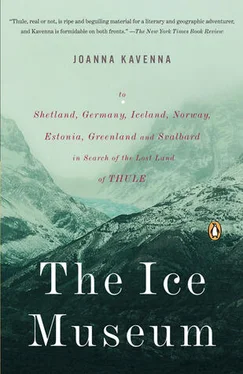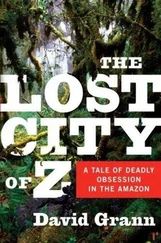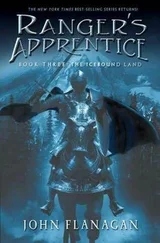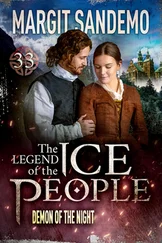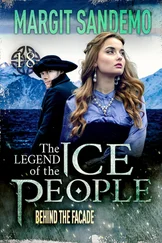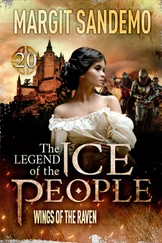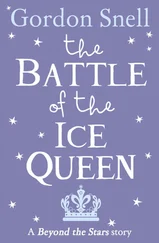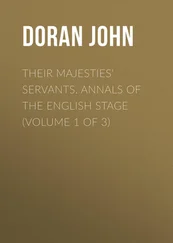He looked frustrated, as he nodded sternly, bowing slightly, shuffling along the corridor to a meeting. He wouldn’t say what it was about. ‘Business, business,’ he said, clinking his sword against his belt buckle.
In the Kalevala , the Finnish epic, Northland, or Lapland, was a place of darkness and magic, a perilous place. The heroes Lemminkäinen, Väinämöinen and Ilmarinen wander the north: god-heroes, reciting verses and having fights. They slide through the frost-covered lands in the far north; they move through the wilds, hearing the dogs barking and Lapland’s children crying, and the women laughing. Lapland is a fabulous place in the poem—the barren lands, the unsown pastures, the battlefields, the rustling grasses, the vast oceans, the black mud of the seas, the smoking whirlpools, the rapids, the clouds and gales and wind-blasted lands. It is a place where there is no daylight through the winter, it is the dreary north, its shadows veiling the lives of the inhabitants.
In the Kalevala , Väinämöinen is taken on an eagle’s back to the furthest north, to the dark lands of the Lapps. Troubled by the terrain, he lies by a stream crying, asking to go home. Louhi, the queen of the north, rows him to a strange cabin, where she says she will show him the way home if he makes something for Lapland, an object called the Sampo—a sort of grail. Väinämöinen promises to send Ilmarinen, the smith, to forge the Sampo.
Väinämöinen returns home, and asks the wind to carry Ilmarinen to the dark lands of the north. The smith lights his fire, makes his bellows, and sets up a forge. Ilmarinen produces the bizarre object, the Sampo, with a corn mill on one side, a salt mill on another, a money mill on another, and a gleaming bright lid. The queen of the north takes the Sampo into the rocky mountains of Lapland, and buries it. Meanwhile the rogue Lemminkäinen decides to travel to Lapland. He visits Kauppi the Lapp to get some skis, and goes sliding through the wilds, skiing across swamps and over the blackened hills. Trying to win the girl of the north, Louhi’s daughter, Lemminkäinen is killed. His mother comes to find him, travelling through the swamps as a wolf, through the waters as an otter, pushing aside the rocks and the stumps, searching for her son. When she finds him, dead in the river, she sews him back together again.
The north has something in it of the Underworld; Tuoni’s black river runs like the Styx. Louhi is an ancient hag of the north, controlling events with a malevolent will. But Lapland is also where the beautiful girl of the north lives, and after Lemminkäinen has failed, Väinämöinen and Ilmarinen join the suitors’ fray. She chooses Ilmarinen and prepares to leave the north, regretting the loss of her simple life, spent growing strawberries and flowers, eating butter and pork, leaving cares to the fir trees, to the birches on the heath.
Lemminkäinen, restored to life, kills the master of Lapland, and Lapland prepares for war. Fleeing from the armies, Lemminkäinen sets out by sea towards the north-west, but Louhi sends the Frost to follow him, and Lemminkäinen is forced to leave the ship and walk across the ice. Ilmarinen’s wife, the girl of the north, is killed by a serf, and though Ilmarinen tries to console himself by forging a wife from gold, he fails. So he returns to Lapland, to ask for the other daughter of the north. He is refused, but he sees that the land is prosperous because of the Sampo, because it grinds things to eat, and things to sell and things to store at home. So Väinämöinen and Ilmarinen, with Lemminkäinen, decide to return to Lapland, to take the Sampo. The Kalevala culminates in a great war between Lapland and the animistic forces of Väinämöinen and his men. When Väinämöinen and his band claim the Sampo, Lapland becomes poor.
‘And the Lapps became poor,’ said Pal, looking at his watch. ‘We lived in an uncertain land through the century, invaded and invaded again, its borders changing hands, from Finland to Germany to Russia, from Russia to Finland. We sat the century out, waiting for the wars to end.’
There was a strange atmosphere in their lush pine palace, a palace without any real power, because the Sámi were the dependents of Scandinavian governments, given a sort of guilt money, reparations for years of neglect. When I shook Pal’s hand, and he unlocked the pine gates, gently pushing me back out into the windy street, I left feeling that some deep-lying dissatisfaction haunted the Sámi, some sense of ancient pride subjected to a continued humiliation. They told me they were poor people, living in countries they did not govern. About the important things, they said, they had no choice.
The Hyperboreans had escaped Nemesis, the Greeks wrote, but it was impossible to maintain the ideal of a remote north that escaped the ravages of the twentieth century. The white wilderness of Siberia became a place of prison camps and death; the white lands were spotted with the dark shapes of prisoners, dragged in chains. Nuclear submarines ploughed through the Arctic Ocean, conducting clandestine operations during the Cold War. Secret military bases were set up in Alaska, in Greenland, in Siberia. The Sámi had watched the Second World War, the German soldiers torching the towns. They had seen the official borders—lines which meant nothing to them, cutting through the lands they lived in—shifting throughout the centuries, as the regions fell under the sway of the Scandinavian monarchs, or the Russian tsars, later the Soviet Army, stamping through the north during the Second World War.
For a few moments, as the wind blasted across the hills and the evening fell, I thought I could go south. I could end there: it was a neat decline from ideal to disaster, from innocence to experience. It supplied the resounding note, the cymbal crash, with the explorers and Victorians coming on for a curtain-bow—the dream of Thule, bound into the polar craze in the late nineteenth century, savaged by 1945. I was gathering the Victorians, Burton, Tweedie and Trollope, the explorers, Nansen and Amundsen, into a choir, imagining them singing a mournful elegy, a lament to the lost ideal of Thule. Poor Thule, they were singing, sotto voce, ruined by the century, the perfect place, dragged into a terrible war. I found myself thinking of London, wondering if I should get back to my life in the city. It was late summer in London. The parks would still be green, the trees still decked with leaves. I could go back to the flat overlooking the Westway, and watch cars passing over the bridge, moving above the trees and houses. I could watch the streetlights turning orange in the early evening, and the neon strips flickering in kitchens below the Westway, walls vibrating to the rhythm of the cars passing overhead. I could return to the honest complexity of the city, a place where the present was raucous and the past was omnipresent. The city didn’t feign a peacefulness it would fail to surrender. The city flaunted its antiquity, its violence and tragedy.
But I quelled my impulse to go home. I had begun with a series of questions. I had wanted to know what happened after the war, why the US Military had called its air base Thule, why Thule still meant northern wilderness, why the Nazis had failed to taint the myth. The Nazi version of Thule said nothing about the original fragments; it was merely eloquent about the minds of those who had misconstrued them. The ancient debate across millennia had been viciously interrupted, but I knew that it continued beyond the war. The mysterious history of Thule attracted others, with different secrets to hide, different dreams, living through the post-war years. The northern rocks and lakes were still gaudy in the summer sunshine; the allure of emptiness retained its potency. I had seen the travellers on the boat, watching the scenery; I had watched with them, mesmerized by the glow of the midnight sun hovering above the waves. There were questions left unanswered, lingering in the northern dusk. Leaving the Sámi town, and heading back to the airport of Kirkenes, I wanted even more to know about the post-war fortunes of Thule. What happened to Thule after the quiet lands of the north had been devastated, drawn into the carnage of World War Two? Who had picked up the skein again, the ancient argument about Thule?
Читать дальше
